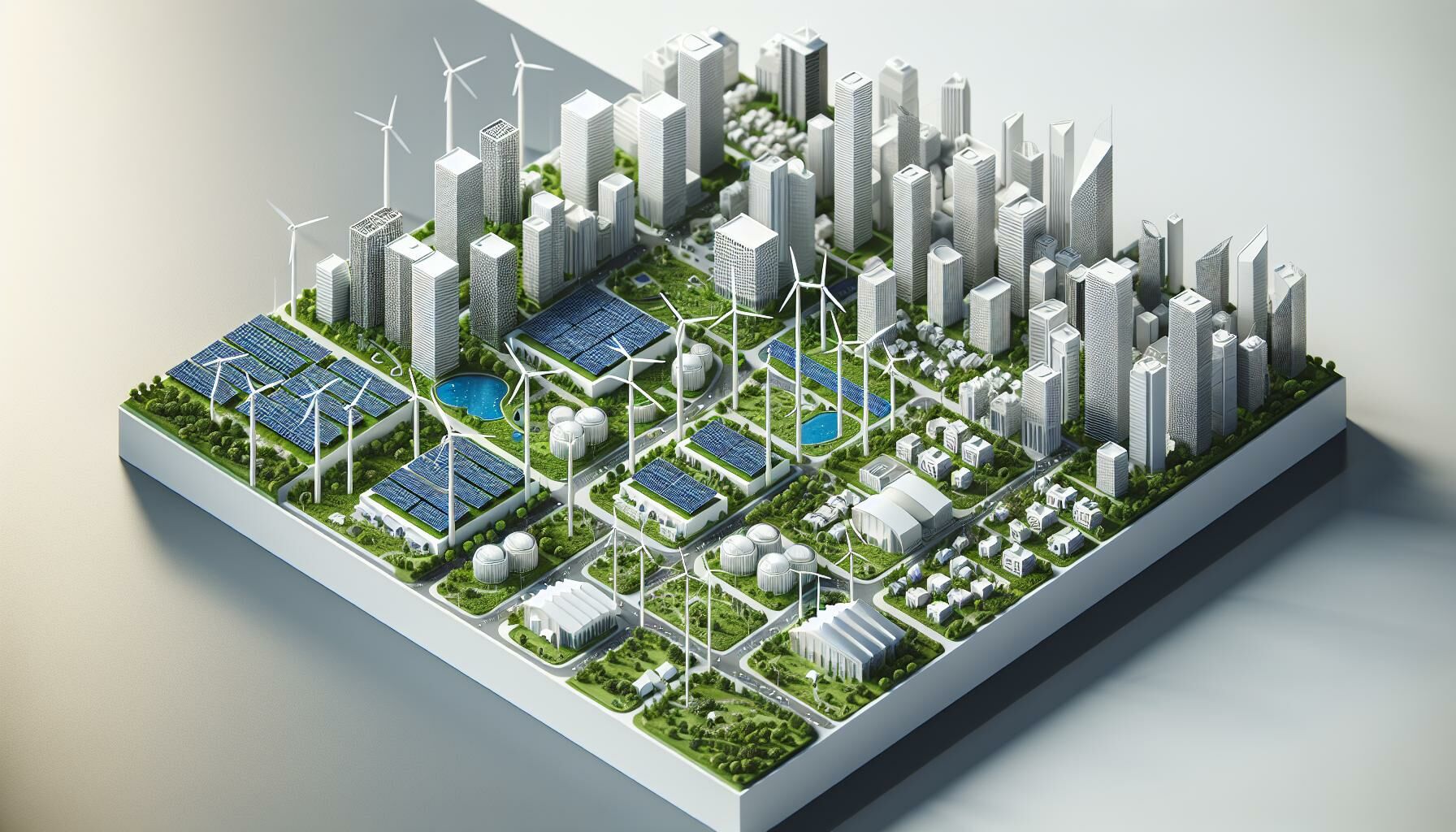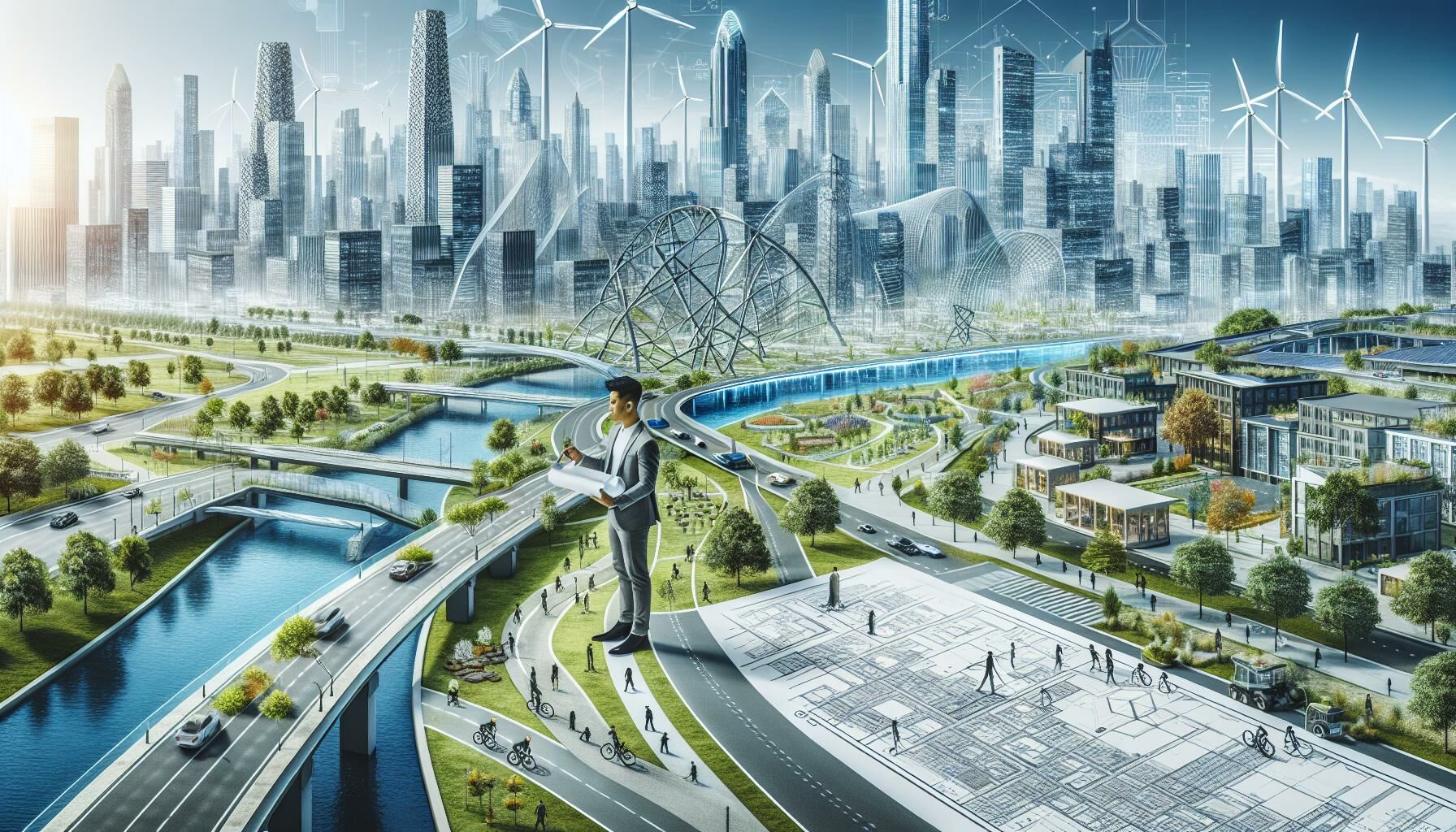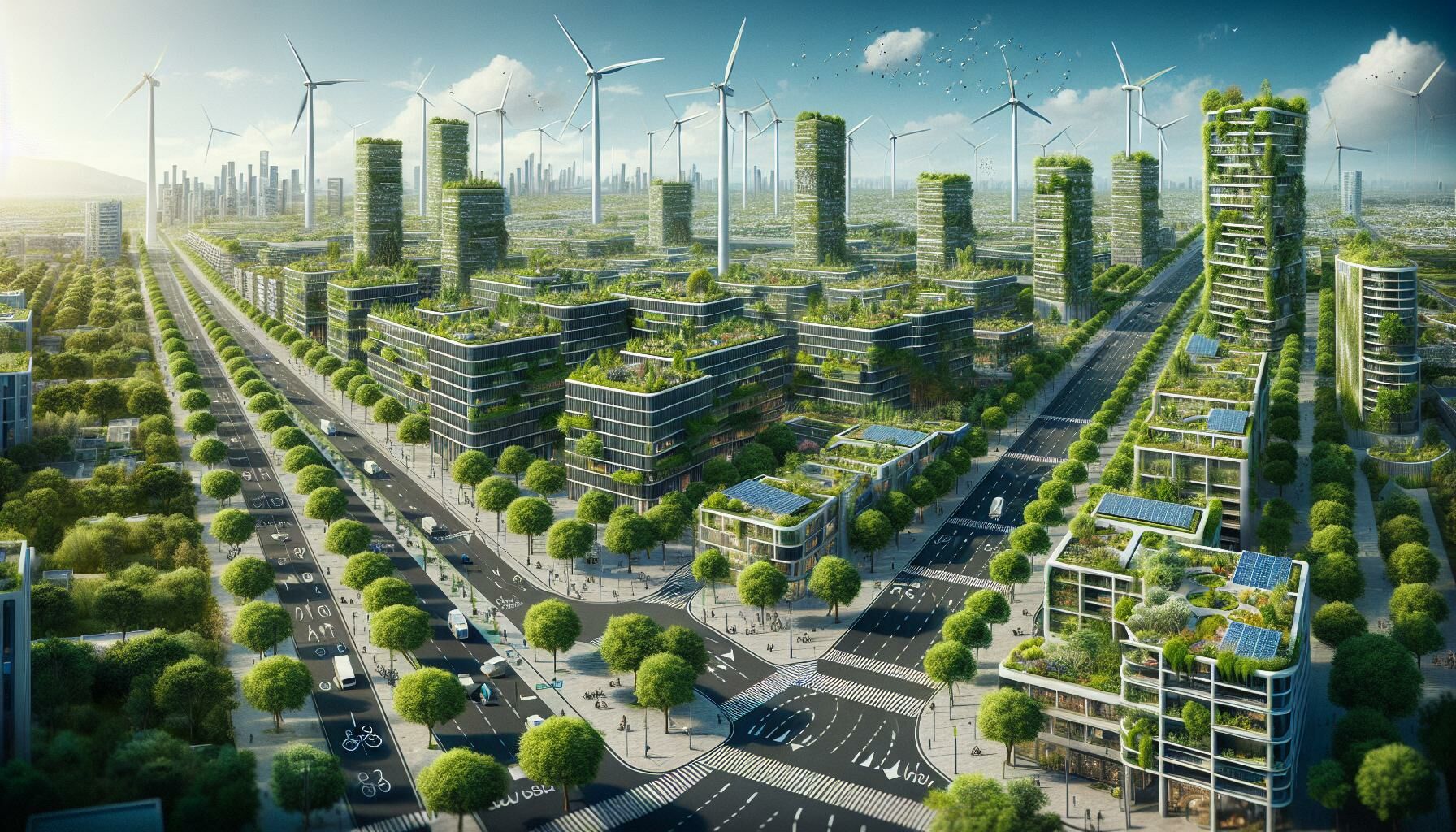Advancements in sustainable infrastructure for urban renewal

In today’s world, there are many advantages of energy-efficient buildings, eco-friendly transportation systems, autonomous smart cities, sustainable infrastructure, and the use of renewable energy sources. These innovations are pinpointed as essential in diminishing carbon emissions, conserving energy, and bolstering our infrastructure’s resilience.
The narrative highlights that these technological advancements not only safeguard the environment but also bring economic benefits and community support to the forefront. It demonstrates how green technologies are progressively integrated into various projects, projecting a future where urban spaces become more sustainable, cleaner, and desirable places to live.
Global challenges and trends necessitating sustainable infrastructure
Climate Change
The Earth is currently undergoing a noticeable rise in temperature, which significantly influences weather patterns, leading to erratic storms and unpredictable rainfall. It is crucial that we commit to developing infrastructure designed to endure these extreme climatic changes.
Integrating advanced and environmentally sustainable technology within our infrastructure and transportation strategies is essential for improving resilience to natural challenges. Moreover, eco-friendly buildings play a significant role in reducing energy consumption and minimising the emission of harmful pollutants. Adopting this approach is vital in making a meaningful contribution to combating climate change.
Population growth and urbanisation
As the global population grows and urban areas expand swiftly, it becomes essential to focus on the sustainability of our urban environments. With a rising number of people moving to cities, prioritising environmentally friendly construction methods is crucial for sustainable development.
This involves developing efficient, livable spaces that minimise environmental harm and encourage the conservation of resources. Implementing sustainable urban strategies, such as comprehensive public transportation systems and integrating green spaces, is key in addressing these challenges effectively.
Resource scarcity
Discussing the depletion of critical resources like water, energy, and various raw materials is essential for our daily lives. Emphasising the adoption of sustainable practices is crucial. This involves a strategic approach to resource management, including integrating renewable energy sources and recycling water. These steps are vital in reducing the rapid consumption of these important resources. By adopting these strategies, we protect our environment and secure the availability of these resources for future generations. The importance of sustainability in this context deserves more focus and consideration.
Environmental degradation
Addressing critical environmental challenges, including pollution, deforestation, and the diminishing of wildlife habitats, is imperative. It’s essential to reconsider our approaches to urban development. Envision urban infrastructure—comprising roads, buildings, parks—that actively benefits the environment.
Leveraging cutting-edge technology in construction and crafting urban areas that mitigate pollution while embracing nature within cityscapes are fundamental measures. Embracing sustainable building methods is crucial for minimising environmental footprints and ensuring the preservation of our planet for future generations.
Importance of sustainable infrastructure development

Environmental conservation
To effectively reduce pollution and protect our planet, incorporating sustainable technology in construction projects is crucial. It’s essential to utilise environmentally friendly resources, including renewable energy sources and materials that do not harm the ecosystem. Adopting these practices can drastically lower the carbon footprint of construction projects. Moreover, this strategy aids in conserving plant and animal life, promoting biodiversity, and maintaining air and water quality. Additionally, adopting green construction techniques is vital in addressing climate change, offering advantages for both current and future generations.
Resource efficiency
Sustainable infrastructure is centred on maximising resource efficiency, encompassing the energy consumption of buildings and the materials employed in their construction. Through the implementation of recycling practices, the preference for renewable resources, and waste reduction efforts, sustainable technology fosters a shift towards a more effective and circular economy. This strategy not only preserves essential resources but also guarantees that urban development is viable and advantageous for environmental health.
Social and economic benefits
Delving into sustainable infrastructure underscores its profound impact on economic and social well-being. Parks and buildings designed with both beauty and energy efficiency in mind greatly improve our life quality by encouraging health and well-being. Moreover, the investment in green technology is a win-win proposition. It creates job opportunities, drives innovation, and results in significant savings on energy bills and healthcare expenses. These environmentally conscious efforts also guarantee that all community members have equal access to the benefits provided. Clearly, the importance of sustainable infrastructure is undeniable.
Resilience and adaptability
Sustainable infrastructure is built to endure the impacts of natural events, including escalating sea levels and significant temperature changes. The development of green buildings and urban areas emphasises resilience, employing sustainable technologies for rapid disaster recovery. This approach safeguards lives and economic assets alike. Moreover, it secures the long-term sustainability of cities against unpredictable environmental shifts caused by nature. This method not only conserves resources but also enhances the adaptability and durability of urban environments in response to ecological challenges.
Long-term cost savings
Investing in sustainable infrastructure from the start can lead to substantial financial savings over time. The advantages are clear: decreased energy consumption, reduced maintenance costs, and a minimised need for frequent upgrades offer significant economic benefits. By focusing on sustainability and efficiency from the beginning, municipalities and communities can realise major savings. In essence, directing funds towards sustainable initiatives today is a wise choice for long-term financial stability.
Social and economic benefits of sustainable infrastructure

Social benefits
Sustainable infrastructure prioritises improving the quality of life for everyone. By adopting eco-friendly measures, it ensures cleaner air, water, and surroundings, which significantly enhance public health. Imagine urban landscapes filled with green spaces and reduced smog levels; these scenarios are not just visually appealing but play a crucial role in lowering the incidence of pollution-related illnesses. This strategy not only boosts individual health but also offers economic advantages by cutting down healthcare costs. It represents an effective approach worth noting.
Enhanced quality of life
Did you know that life greatly improves in areas with sustainable features? Think about parks, efficient public transportation, and sources of renewable energy. These components lead to a cleaner and healthier living environment. Urban spaces that focus on these initiatives tend to improve the viability of walking or cycling, minimising dependence on conventional fuels and encouraging physical activity. Together, these actions significantly boost the quality of life in such areas, making cities more appealing places to live.
Community engagement
Sustainable infrastructure projects emphasise the importance of community engagement, aiming to ensure that development efforts are in harmony with the collective needs and aspirations of locals. Engaging community members in the decision-making process transcends obtaining their approval; it is about promoting inclusion and encouraging participation in a wider vision. This strategy not only builds a communal sense of ownership and pride in these projects but also motivates individuals to embrace environmentally sustainable practices in their daily routines.
Education and skill development
Investing in sustainable infrastructure projects offers substantial benefits in enhancing education and job skills, especially in the field of green technology, an area acknowledged as essential amid growing environmental awareness. Educational institutions and community organisations that prioritise environmental sustainability initiatives stand to gain exceptional career prospects within the burgeoning green economy. Additionally, they acquire the crucial advantage of hands-on experience with sustainable technologies, preparing them with the key skills required for future employment opportunities.
Technological innovations in sustainable infrastructure
Sustainable technology is crucial in creating green, inclusive, and economically viable urban environments. This article delves into the innovative technological advancements driving the shift towards a more sustainable future.
Solar and wind advancements
In the current discussion on environmental sustainability, it’s clear that progress in solar and wind technology plays a crucial role in facilitating greener practices. The development of photovoltaic cells, essential for solar panels, and advancements in wind turbine efficiency are driving down consumer costs. This evolution not only promotes an eco-friendly methodology for energy generation but also demonstrates our growing ability to utilise natural resources effectively without harming the environment.
Innovative hydropower
The conversation around hydropower has evolved beyond the large dams that defined earlier periods. Nowadays, there’s a pronounced trend towards adopting smaller and portable turbines. These cutting-edge turbines boast remarkable versatility, enabling deployment in remote areas or incorporation into larger grid initiatives. This contemporary take on hydropower marks a major shift in renewable energy practices, presenting broader prospects for tapping into clean energy sources and promoting environmental sustainability.
Smart technologies for resource management:
Intelligent technology is profoundly revolutionising the way resources are managed. By leveraging advanced sensors, artificial intelligence (AI), and data analysis tools, urban regions can improve energy consumption, conserve water, and optimise the distribution of resources. These technologies go beyond innovation; they play a crucial role in enabling informed decision-making that supports sustainable urban growth, minimises waste, and enhances efficiency.
Building management systems
Building management systems (BMS) play a crucial role in embedding sustainable technology into urban landscapes, acting as the core intelligence for buildings. They are essential for optimising both comfort and eco-friendliness through operational efficiency and energy conservation. As urban populations expand, BMS becomes increasingly vital in improving the ecological sustainability of new and existing buildings.
Recommendations for future sustainable infrastructure projects
Integrating sustainable technology in construction and development is crucial for environmental preservation, community well-being, and job sustainability. Utilising renewable energy sources, employing innovative construction methods, and incorporating intelligent technology are vital components of any new project.
These methods are effective in reducing pollution, improving life quality, and creating job opportunities that support environmental conservation.
As cities continue to grow and change, integrating green technologies into their development strategies is essential for ensuring progress that does not sacrifice ecological health. This approach aims at building a future where environmental sustainability and urban development can coexist without conflict. Success in this area demands a collaborative effort from government bodies, local business leaders, and citizens. Through collective action, it’s possible to establish a model of advancement that does not harm the environment.
Latest Thailand News
Follow The Thaiger on Google News:


























